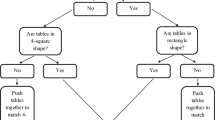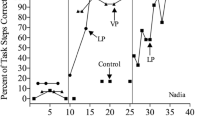Abstract
The purpose of this study was to evaluate the effectiveness of using a video iPod as a prompting device for teaching three job-related tasks to a young man with developmental disabilities in a community-based employment setting. The effectiveness of the prompting device was evaluated using a multiple probe across behaviors design. Results indicated that the introduction of the video iPod was associated with immediate and substantial gains in independent correct responding with an associated decrease in the number of prompts given from a job coach. In addition, the participant used the video iPod independently. Instructional implications and future research will be discussed.


Similar content being viewed by others
References
Billingsley, F. F., White, O. R., & Munson, R. (1980). Procedural reliability: A rationale and an example. Behavioral Assessment, 2, 229–241.
Cannella-Malone, H., Sigafoos, J., O’Reilly, M., De la Cruz, B., Edrisinha, C., & Lancioni, G. E. (2006). Comparing video prompting to video modeling for teaching daily living skills to six adults with developmental disabilities. Education and Training in Developmental Disabilities, 41, 344–356.
Cihak, D. F., Alberto, P. A., Kessler, K., Taber-Doughty, T., & Gama, R. I. (2006). A comparison of static picture prompting and video prompting simulation strategies using group instructional procedures. Focus on Autism and Other Developmental Disabilities, 21, 89–99. doi:10.1177/10883576060210020601.
Cihak, D. F., Kessler, K. B., & Alberto, P. A. (2007). Generalized use of a handheld prompting system. Research in Developmental Disabilities, 28, 397–408. doi:10.1016/j.ridd.2006.05.003.
Cihak, D. F., Kessler, K., & Alberto, P. A. (2008). Use of a handheld prompting system to transition independently through vocational tasks for students with moderate and severe intellectual disabilities. Education and Training in Developmental Disabilities, 43, 102–110.
Collins, B. C. (2007). Moderate and severe disabilities: A foundational approach. Upper Saddle River, NJ: Pearson Education, Inc.
Copeland, S. R., & Hughes, C. (2000). Acquisition of a picture prompt strategy to increase independent performance. Education and Training in Mental Retardation and Developmental Disabilities, 35, 294–305.
Davies, D. M., Stock, S., & Wehmeyer, M. L. (2002a). Enhancing independent task performance for individuals with mental retardation through use of a handheld self-directed visual and audio prompting system. Education and Training in Mental Retardation and Developmental Disabilities, 37, 209–218.
Davies, D. M., Stock, S., & Wehmeyer, M. L. (2002b). Enhancing independent time management and personal scheduling for individuals with mental retardation through use of a palmtop visual and audio prompting system. Mental Retardation, 40, 358–365. doi:10.1352/0047-6765(2002)040<0358:EITMSO>2.0.CO;2.
Epstein, J. N., Willis, M. G., Conners, C. K., & Johnson, D. E. (2001). Use of a technological prompting device to aid a student with attention deficit hyperactivity disorder to initiate and complete daily tasks: An exploratory study. Journal of Special Education Technology, 16(1), 19–28.
Ferguson, H., Myles, B. S., & Hagiwara, T. (2005). Using a personal digital assistant to enhance the independence of an adolescent with asperger syndrome. Education and Training in Mental Retardation and Developmental Disabilities, 40, 60–67.
Fisher, M. K. (1984). Vocational assembly skills using isometric projection exploded view assembly drawing for mentally handicapped students. Education and Training of the Mentally Retarded, 19, 285–290.
Furniss, F., Lancioni, G., Rocha, N., Cunha, B., Seedhouse, P., Morato, P., et al. (2001). VICAID: Development and evaluation of palmtop-based job aid for workers with severe developmental disabilities. British Journal of Educational Technology, 32, 277–287. doi:10.1111/1467-8535.00198.
Gast, D. L., Skouge, J. R., & Tawney, J. W. (1984). Multiple baseline designs. In J. W. Tawney & D. L. Gast (Eds.), Single subject research in special education (pp. 226–268). Columbus, OH: Merrill.
Goodson, J., Sigafoos, J., O’Reilly, M., Cannella, H., & Lancioni, G. E. (2007). Evaluation of a video-based error correction procedure for teaching a domestic skill to individuals with developmental disabilities. Research in Developmental Disabilities, 28, 458–467. doi:10.1016/j.ridd.2006.06.002.
Graves, T. B., Collins, B. C., Schuster, J. W., & Kleinert, H. (2005). Using video prompting to teach cooking skills to secondary students with moderate disabilities. Education and Training in Developmental Disabilities, 40, 34–46.
Horner, R. D., & Baer, D. M. (1978). Multiple-probe technique: A variation of the multiple baseline design. Journal of Applied Behavior Analysis, 11, 189–196. doi:10.1901/jaba.1978.11-189.
Lancioni, G. E., & O’Reilly, M. F. (2001). Self-management of instruction cues for occupation: Review of studies with people with severe and profound disabilities. Research in Developmental Disabilities, 22, 41–65. doi:10.1016/S0891-4222(00)00063-9.
Lancioni, G. E., & O’Reilly, M. F. (2002). Teaching food preparation skills to people with intellectual disabilities: A literature overview. Journal of Applied Research in Intellectual Disabilities, 15, 236–253. doi:10.1046/j.1468-3148.2002.00122.x.
Lancioni, G. E., O’Reilly, M. F., Seedhouse, P., Furniss, F., & Cuhna, B. (2000). Promoting independent task performance by persons with severe developmental disabilities through a new computer-aided system. Behavior Modification, 24, 700–718. doi:10.1177/0145445500245005.
Lancioni, G. E., O’Reilly, M. F., Van den Hof, E., Furniss, F., Seedhouse, P., & Rocha, N. (1999a). Task instructions for persons with severe intellectual disability: Reducing the number of instruction occasions after the acquisition phase. Behavioral Interventions, 14, 199–211. doi:10.1002/(SICI)1099-078X(199910/12)14:4<199::AID-BIN35>3.0.CO;2-E.
Lancioni, G. E., Van den Hof, E., Boelens, H., Rocha, N., & Seedhouse, P. (1998). A computer-based system providing pictorial instructions and prompts to promote task performance in persons with severe developmental disabilities. Behavioral Interventions, 13, 111–122. doi:10.1002/(SICI)1099-078X(199805)13:2<111::AID-BIN10>3.0.CO;2-0.
Lancioni, G. E., Van den Hof, E., Furniss, F., O’Reilly, M. F., & Cunha, B. (1999b). Evaluation of a computer-aided system providing pictorial task instructions and prompts to people with severe intellectual disability. Journal of Intellectual Disability Research, 43, 61–66. doi:10.1046/j.1365-2788.1999.43120165.x.
Martin, J. E., Mithaug, D. E., & Burger, D. L. (1990). Effects of visual cues upon the vocational task performance of students with mental retardation. Exceptionality, 1, 41–59.
Martin, J. E., Mithaug, D. E., & Frazier, E. S. (1992). Effects of picture referencing on PVC chair, loveseat, and settee assemblies by students with mental retardation. Research in Developmental Disabilities, 13, 267–286. doi:10.1016/0891-4222(92)90029-6.
Pinnacle Systems. (2005). Pinnacle studio 10 [Computer Software]. Tewksbury, MA: Author.
Riffel, L. A., Wehmeyer, M. L., Turnbull, A. P., Lattimore, J., Davies, D., Stock, S., et al. (2005). Promoting independent performance of transition-related tasks using a palmtop pc-based self-directed visual and auditory prompting system. Journal of Special Education Technology, 20(2), 5–14.
Sigafoos, J., O’Reilly, M., Cannella, H., Edrisinha, C., de la Cruz, B., Upadhyaya, M., et al. (2007). Evaluation of a video prompting and fading procedure for teaching dish washing skills to adults with developmental disabilities. Journal of Behavioral Education, 16, 93–109. doi:10.1007/s10864-006-9004-z.
Sigafoos, J., O’Reilly, M., Cannella, H., Upadhyaya, M., Edrisinha, C., Lancioni, G. E., et al. (2005). Computer-presented video prompting for teaching microwave oven use to three adults with developmental disabilities. Journal of Behavioral Education, 14, 189–201. doi:10.1007/s10864-005-6297-2.
Taber-Doughty, T., Patton, S. E., & Brennan, S. (2008). Simultaneous and delayed video modeling: An examination of system effectiveness and student preferences. Journal of Special Education Technology, 23(1), 1–18.
Van Laarhoven, T., & Van Laarhoven-Myers, T. (2006). A comparison of three video-based instructional procedures for teaching daily living skills to persons with developmental disabilities. Education and Training in Developmental Disabilities, 41, 365–381.
Van Laarhoven, T., Van Laarhoven-Myers, T., & Zurita, L. M. (2007). The effectiveness of using a pocket pc as a video modeling and feedback device for individuals with developmental disabilities in vocational settings. Assistive Technology Outcomes and Benefits, 4(1), 28–45.
Wacker, D. P., & Berg, W. K. (1983). Effects of picture prompts on the acquisition of complex vocational tasks by mentally retarded adolescents. Journal of Applied Behavior Analysis, 16, 417–433. doi:10.1901/jaba.1983.16-417.
Wechsler, D. (1991). Wechsler intelligence scale for children (3rd ed.). San Antonio, TX: Psychological Corporation.
Wolery, M., Ault, M. J., & Doyle, P. M. (1992). Teaching students with moderate to severe disabilities: Use of response prompting strategies. New York: Longman.
Wolery, M., Bailey, D. B., & Sugai, G. M. (1988). Effective teaching: Principles and procedures of applied behavior analysis with exceptional students. Needham, MA: Allyn and Bacon.
Wolery, M., & Gast, D. L. (1984). Effective and efficient procedures for the transfer of stimulus control. Topics in Early Childhood Special Education, 4, 52–77.
Wolery, M., & Schuster, J. W. (1997). Instructional methods with students who have significant disabilities. The Journal of Special Education, 31, 61–79.
Woodcock, R. W., Kevin, S., McGrew, K. S., & Mather, N. (2001). Woodcock-Johnson ® III NU tests of achievement. Rolling Meadows, IL: Riverside publishing.
Author information
Authors and Affiliations
Corresponding author
Rights and permissions
About this article
Cite this article
Van Laarhoven, T., Johnson, J.W., Van Laarhoven-Myers, T. et al. The Effectiveness of Using a Video iPod as a Prompting Device in Employment Settings. J Behav Educ 18, 119–141 (2009). https://doi.org/10.1007/s10864-009-9077-6
Received:
Accepted:
Published:
Issue Date:
DOI: https://doi.org/10.1007/s10864-009-9077-6




